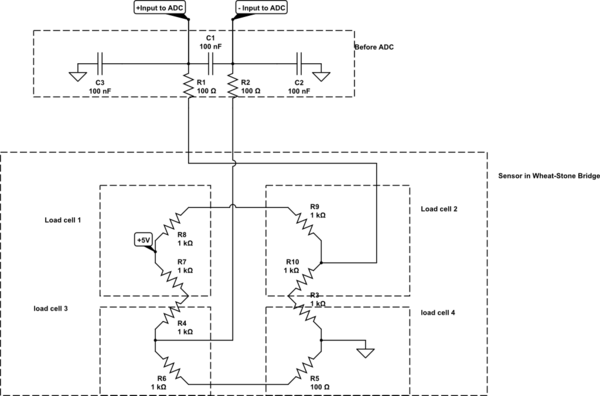If ADC is 3V, unless its input is stable to within 3/2^20, you will get fluctuations.
What would be max weight you need to display. & Min Resolution desired. & Fluctuation allowed: short term : within say 5 secs. long terms say over 1 hour.
I doubt whether anybody has achieved a stability of 50kg/2^20 ever, and whether it is necessary to achive that stability. What is the acceptable stability. And do not forget to distinguish between accuracy and resolution. I had a look at the sensors and find that you may be looking at a mximum of 200kg using four 50kg sensors. a resolution of 100gm is adequate, and fluctutaions more than =/- 100gms can be a nuisance. it could be becuase of improper excitation stability, pick up due to 50 hz and a host of other things. you should use a differential amplifier and may use a 1hz low pass filter (digital or analog) to filter the 50 hz variations if fluctutaions are due to mains. Make sure that the loading platform is very stable. Apparent weight changes of 0.19 gm can be identified by the 20 bit Adc and what you require is just a 11 bit ADC actually. so fluctations of 2^9 bits = 512 counts are just accepatble!!!
YOU DO HAVE A DIFFERENTIAL AMPLIFIER BUT I DOUBT WHETHER YOUR CIRCUIT IS SINGLE ENDED (IF THAT IS SO IT EXPLAINS THE FLUCTUTAIONS). GTE TO KNOW HOW ONE MAKES A DIFFERENTIAL AMPLIFIER -- A BOON TO ALL LOW LEVEL MEASUREMENTS IN THE PRESENCE OF MAINS INTERFERENCE.
The parameters of MLC902 as follows: comprehensive error: 0.2%FS output resistance: 1000±10Ω Rated output: 1.0/0.5±0.15mv/v Insulation resistance: ≥2000MΩ(100VDC) Non-linearity: 0.2%FS Excitation voltage: 5~10VDC Hysteresis: 0.2%FS compensated temp: -10~+40ºC Repeatability: 0.15%FS use temperature: -20~+55ºC Creep: 0.15%FS/10MIN temp effect on zero: 0.2%FS/10ºC Zero balance: ±0.3mv Temp effect on span: 0.2%FS/10ºC. So identify what each error means. It is possible that the erros add up to worse than 0.2% and hence a 11 bit ADC is more than adequate, as it will enable you to get a resolution of 100gms in 200Kg FS. Note that 0.2% is 400gms.
If you plan to use the ADC so that 200kg will mean about 80% of ADC range, simply making all the last 9 bits as zero will be acceptable and fluctuations will hopefully not bother you.. To get benefits of differential amplification, please connect the ground of signal output of sensor not directly but through a 100 ohms to ground. The junction of 100 ohms and load sensor will be input Lo. Input Hi is the other output point of load sesnor as already existing. The difference is then amplified, and 50 hz will now cause much less problems.

